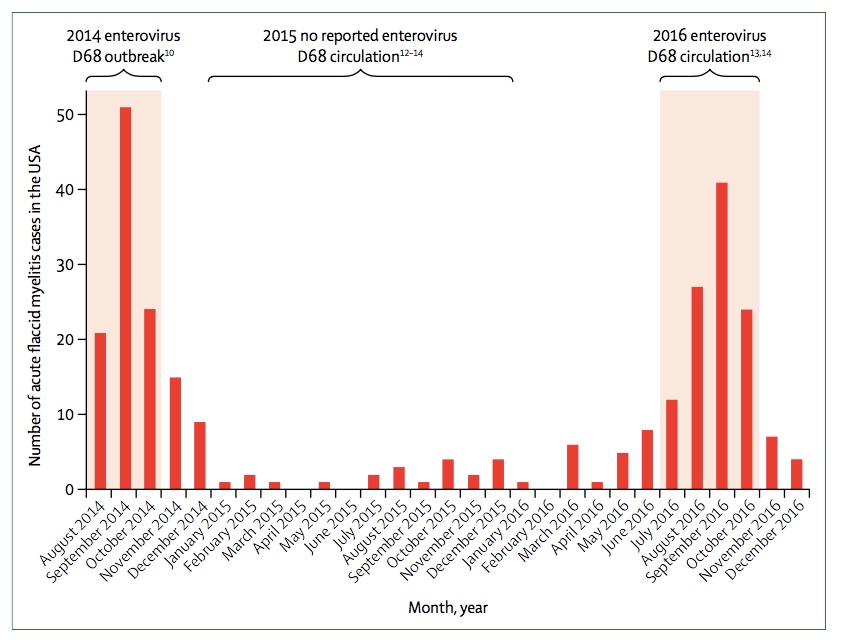You may remember a mystery that had health officials and the Centers for Disease Control (CDC) perplexed a few summers back. We covered the story here.
During the summer of 2012, people (mostly children) in California were getting sick and some, as a result, were becoming paralyzed. This had not been seen since the introduction of the polio vaccine in 1955.
The neurological disease was described as polio-like. It was designated acute flaccid myelitis (AFM) and multiple hypotheses were tossed around as to its cause.
A paper recently published in The Lancet Infectious Diseases offers a strong suggestion (in the form of a Personal View) that enterovirus D68, one of the hypotheses that had always been at the forefront of the pack, is indeed one of the causes.
Enterovirus D68 was discovered in 1962 after being isolated from respiratory specimens of children with pneumonia in California. Although in the name family as poliovirus, enterovirus D68 is classified as a non-polio enterovirus and actually behaves much more like a rhinovirus (the virus that causes the common cold). Not much was known about Enterovirus D68, with only 26 cases reported from 1970 to 2005.
In 2014, the USA experienced a large enterovirus D68 outbreak, with 1153 confirmed infections, but ten to a hundred times more suspected cases.
The cases of enterovirus D68 were rising as were the cases of AFM. This can easily be seen in the chart below. The red bars show the number of cases of AFM which happen to peak in the middle of the two last enterovirus D68 outbreaks.

But, scientists know better than to draw a causal relationship from what could be nothing more than a spurious correlations - a strange coincidence.
That notwithstanding, the relationship between enterovirus D68 and AFM remained loose and confusing. Perhaps most perplexing was the fact that not all AFM patients had enterovirus D68 antibodies in their system - the tell tale sign of an infection.
But, a team of physicians at the University of Colorado Medical Center have recently decided to take a closer look. In doing so, they applied the Bradford Hill criteria to the hypothesis. The Bradford Hill criteria are a set of fundamental rules established in 1965 that are designed to establish a causation in the absence of other, more traditional, evidence. They are,
- Strength: The larger the association, the more likely that it is causal.
- Consistency: Consistent findings strengthens the likelihood of an effect.
- Specificity: Causation is likely if there is a very specific population at a specific site and disease with no other likely explanation.
- Temporality: The effect has to occur after the cause.
- Biological gradient: Greater exposure should generally lead to greater incidence of the effect.
- Plausibility: A plausible mechanism between cause and effect is helpful.
- Coherence: Coherence between epidemiological and laboratory findings increases the likelihood of an effect.
- Experiment: Occasionally it is possible to appeal to experimental evidence.
- Analogy: The effect of similar factors may be considered.
Using these criteria, the causal relationship between enterovirus D68 and AFM is supported. More specifically, the criteria of strength, consistency, temporality, plausibility, coherence, experiment, and analogy all lead to a causal relationship.
The authors are not claiming a conclusion based solely on this. They are careful to state that "Prospective studies evaluating the epidemiological association between enterovirus D68 and AFM are needed" and that enterovirus D68 would only count as one of several pathogens with the capacity to cause AFM.
That said, because enterovirus D68 infections are probably under-recognized and under-reported, a more active and global system of reporting is imperative.
Perhaps with closer monitoring and more information, the final link can be made regarding this mysterious illness.
Source: Kevin Messacar. Enterovirus D68 and acute flaccid myelitis—evaluating the evidence for causality Lancet Infect Dis 2018 February 23, 2018 http://dx.doi.org/10.1016/ S1473-3099(18)30094-X




